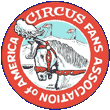

North America's Leading Circus Fan Organization - Founded 1926
| News | Events | Photos | Resources | About Us |
 |
 North America's Leading Circus Fan Organization - Founded 1926 |
||||
|
|
Copyright © 1999-2015 Circus Fans Association of America and Authors. For more information view our Copyright Policy & Privacy Policy . |
|